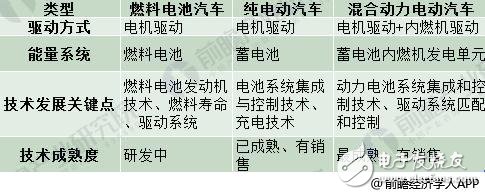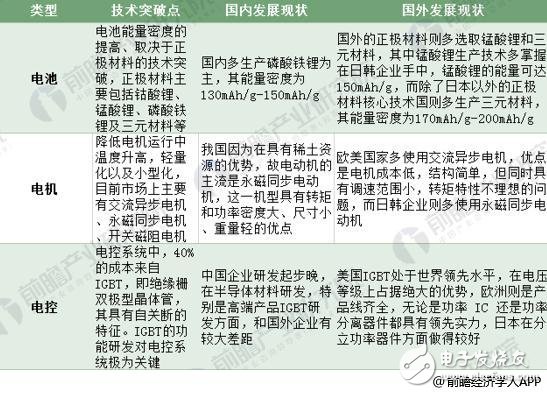The Chinese government attaches great importance to energy conservation and emission reduction in the transportation sector and the sustainable development of transportation energy. After years of efforts, China has established a hybrid vehicle, a pure electric vehicle, and a fuel cell vehicle as "three verticals" and with batteries, motors and electricity. Controlled "three horizontal" R & D layout and technical system. Let's take a look at the related content with the car electronics editor.
In the "three horizontal" system, the battery is the core "core" of the motor, which is a key factor that restricts the length of the stroke. The motor is the converter between electric energy and mechanical energy, and the electric control is to coordinate the high efficiency operation of the motor. And the key factors for safe implementation.
Figure 1: The meaning and specific role of motor, battery, and electronic control

The "three verticals" system includes China's major energy vehicles - fuel cell vehicles, pure electric vehicles and hybrid electric vehicles. From the key points of the technical development of the three major energy vehicles, the technological development of batteries, motors and motor control is a key factor restricting the development of major new energy vehicles.
Figure 2: Comparison of major new energy vehicle technology routes

In the development of new energy vehicle batteries, motors, and electronic control technology, there is a big gap between domestic and foreign technology development. In the field of battery technology research and development, energy density is a very important indicator. Because the total electricity = battery quantity & TImes; battery energy density, the energy density of the battery is an important factor affecting the length of the mileage. The positive electrode material of the battery is a breakthrough point that greatly increases the energy density of the battery. The domestic cathode materials are mostly lithium iron phosphate, and the energy density is far lower than the energy density of lithium manganate and ternary materials abroad. Therefore, in terms of battery technology development, the domestic and foreign strengths are quite different.
Prospective Industry Research Institute "2018-2023 China's new energy automotive motor and controller industry market demand and investment planning analysis report" data show that in the field of motor technology development, because China has the advantage of rare earth resources, the production of mainstream motor starting permanent magnet The synchronous motor is close to the Korean home in terms of technology, and has the advantages of small size and light weight compared with AC asynchronous motors in Europe and the United States.
In the field of electronic control technology development, the development of IGBTs, ie insulated gate bipolar transistors, is critical to the breakthrough of electronic control technology and the reduction of electronic control costs. However, looking at the competitive landscape of the global market, European and American countries have absolute advantages in IGBT technology, and they are doing very well in power discrete devices and power ICs, while Japanese companies are inferior to European and American countries in power ICs, but discrete power. The device is doing a good job. However, due to the late start of R&D in China, the technology gap between IGBTs and Europe and the United States and Japan is large.
In summary, China's technological development in battery and electronic control has a large gap with foreign countries. In the technological development of electric motors, it benefits from the advantages of rare earth resources and the level is close.
Figure 3: Technical breakthroughs in batteries, motors, and electronic controls, and development status at home and abroad

European, American, Japanese and Korean homes have formed technical barriers to China in terms of batteries and electronic control.
In the current production of new energy vehicles, in terms of battery and electronic control technology, the level of R&D of domestic enterprises is quite different from that of Europe, America and Japan. European, American, and Japanese Koreans have also consciously blocked China's R&D technology. For example, in the battery market, Europe, the United States, and Japan have adopted a strategy of selling only in China rather than in China. At the same time, European and American countries such as the United States and Canada also The corresponding regulations were introduced to protect the domestic R&D technology from the perspective of national legislation. In a short period of time, it is difficult for China to break through such technical barriers. In terms of technology research and development in key areas of new energy vehicles, there is still a huge gap between the European and American countries.
The new subsidy policy will be launched in 2018 to accelerate the technological development of the new energy auto industry
In February 2018, the State Department of Finance, the Ministry of Industry and Information Technology, the Science and Technology Department and the Development and Reform Commission announced the announcement of the “Notice on Adjusting and Improving the Financial Subsidy Policy for the Promotion and Application of New Energy Vehiclesâ€. So far, the new subsidy policy has been implemented, and the state has The decline in subsidies for the energy auto industry has even completely eliminated the trend. This policy adjustment has two directions. On the one hand, the subsidy threshold is increased. On the one hand, the subsidy for low-grade mileage is reduced, and on the other hand, the subsidy for high-end mileage is improved.
The impact of this policy is enormous, and will greatly promote the survival of the fittest in the new energy automobile industry. The survival pressure of enterprises producing low-energy mileage new energy vehicles will become greater, while those producing high-end-mile mileage energy vehicles will Get more benefits. The two key factors determining the cruising range are the energy density of the battery and the efficiency of the motor's energy conversion. This will prompt the industry to upgrade this technology to achieve self-innovation. Therefore, the landing of the new subsidy policy will greatly promote the development of the new energy automobile industry.
Figure 4: Comparison of subsidies for pure electric vehicles in 2017-2018

Figure 5: 2017-2018 plug-in hybrid vehicle subsidy standard

In summary, at this stage, the development level of China's new energy vehicle technology is still quite different from the level of foreign advanced technology development, and because foreign countries' blockade and protection of domestic R&D technology will make it difficult for China to break through in a short time. Foreign technical barriers, so the local new energy industry will still be affected by foreign companies, but the new subsidy policy will promote the survival of the fittest and technological upgrading of domestic enterprises.
Smart Body Fat Scales,Bathroom Scale,Bluetooth Digital Scale,Scales For Body Weight
C&Q Technology (Guangzhou) Co.,Ltd. , https://www.gzcqteq.com